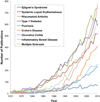Genetics of Sjögren's syndrome in the genome-wide association era
- PMID: 22289719
- PMCID: PMC3518871
- DOI: 10.1016/j.jaut.2012.01.008
Genetics of Sjögren's syndrome in the genome-wide association era
Abstract
While Sjögren's syndrome (SS) is more common than related autoimmune disorders, such as systemic lupus erythematosus (SLE) and rheumatoid arthritis (RA), scientific and medical research in SS has lagged behind significantly. This is especially true in the field of SS genetics, where efforts to date have relied heavily on candidate gene approaches. Within the last decade, the advent of the genome-wide association (GWA) scan has altered our understanding of disease pathogenesis in hundreds of disorders through the successful identification of novel risk loci. With strong evidence for a genetic component in SS as evidenced by familial aggregation of SS as well as similarities between SS and SLE and RA, the application of GWA approaches would likely yield numerous novel risk loci in SS. Here we review the fundamental scientific principles employed in GWA scans as well as the limitations of this tool, and we discuss the application of GWA scans in determining genetic variants at play in complex disease. We also examine the successful application of GWA scans in SLE, which now has more than 40 confirmed risk loci, and consider the possibility for a similar trajectory of SS genetic discovery in the era of GWA scans. Ultimately, the GWA studies that will be performed in SS have the potential to identify a myriad of novel genetic loci that will allow scientists to begin filling in the gaps in our understanding of the SS pathogenesis.
Copyright © 2012 Elsevier Ltd. All rights reserved.
Figures



References
-
- Binard A, Devauchelle-Pensec V, Fautrel B, Jousse S, Youinou P, Saraux A. Epidemiology of Sjogren's syndrome: where are we now? Clin Exp Rheumatol. 2007;25:1–4. - PubMed
-
- Helmick CG, Felson DT, Lawrence RC, Gabriel S, Hirsch R, Kwoh CK, et al. Estimates of the prevalence of arthritis and other rheumatic conditions in the United States. Part I. Arthritis Rheum. 2008;58:15–25. - PubMed
-
- Besana C, Salmaggi C, Pellegrino C, Pierro L, Vergani S, Faravelli A, et al. Chronic bilateral dacryo-adenitis in identical twins: a possible incomplete form of Sjogren syndrome. Eur J Pediatr. 1991;150:652–655. - PubMed
-
- Bolstad AI, Haga HJ, Wassmuth R, Jonsson R. Monozygotic twins with primary Sjogren's syndrome. J Rheumatol. 2000;27:2264–2266. - PubMed
Publication types
MeSH terms
Grants and funding
LinkOut - more resources
Full Text Sources
Medical

